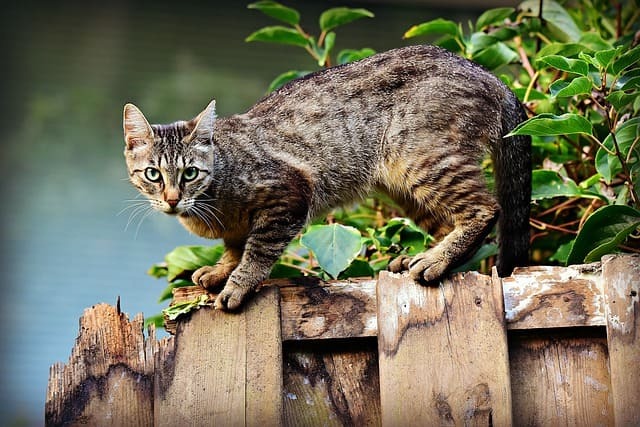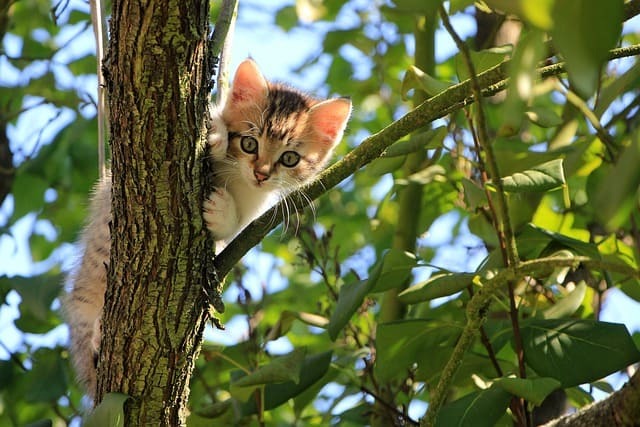















 Back
Back
Why Do Cats Like to Scratch?
Any cat with claws is bound to scratch, but there are plenty of steps owners can take to avoid excessive destruction. Get to the bottom of this common behavior and smooth things over in your home with Animalia’s guide.

Writer Animalia Team

Cats are known for their curiosity, intelligence, and fiercely independent nature. Among their most recognizable behaviors is their tendency to dig their claws into just about anything. Though the habit often leaves household furniture wounded, cats don’t engage in it out of malice. They can’t help themselves!
Scratching is an instinctive behavior for cats, a natural inclination that cats engage in for a variety of reasons. Your feline may be marking their territory, exercising, or shedding troublesome sheaths from their claws. Better understanding the behavior can help divert and control destructive scratching.
The many reasons your cat may be scratching
Cats have a strong instinct to scratch. So strong that cats will thwart even the most persistent attempts to stop their behavior. While you can’t stop a cat from scratching, you can understand it and potentially better manage it. Here are a few possible explanations for feline scratching:
- Cats use scratching as a way to mark their territory. By leaving visual and olfactory marks, cats can signal to other cats when they have been in an area.
- Scratching stretches a cat’s muscles, allowing them to keep their bodies in top condition.
- Cats use scratching to help relieve pent-up stress and frustration.
- When cats scratch, they mimic the motion of stalking and pouncing on prey. This helps them hone their reflexes. If they were in the wild, the behavior could make them a more successful hunter.
- Scratching helps remove the dead outer layer of the claws and encourages the healthy growth of new claws.
- Sometimes cats just like to scratch because it feels good.
As such, the next time you see your cat scratching, don’t be too stressed.They’re not doing anything out of the ordinary.
What do cats like to scratch?
Most cats will happily scratch various surfaces, including cardboard boxes, furniture, sturdy scratching posts, carpeted surfaces, sisal scratching mats, and even trees. While it may seem harmless, scratching can lead to serious damage if not appropriately managed.
Cat scratching can cause a lot of damage to your furniture and belongings if you don’t take the appropriate steps to control it by diverting cats to suitable targets. Cats can create deep grooves in wood furniture and rips and tears in upholstery fabric, leaving unsightly marks throughout the home. It’s important to understand why cats like to scratch in the first place, as this can help you find ways to limit the behavior.
How to stop destructive feline scratching
Some steps and precautions you can take to keep destructive cat scratching at:
Maintain close supervision
To prevent your cat from scratching in inappropriate areas, the best thing you can do is to keep a close eye on them while they play. With close attention, you can intervene and offer alternatives whenever they’re ready to engage in destructive scratching.

Monitoring your cat will help to create a positive association with appropriate targets like scratching posts and discourage them from scratching elsewhere. Remember that plenty of enrichment activities and stimulation will keep a cat entertained and make them less likely to seek out new household objects to scratch.
Buy a scratching post
Most scratching posts are covered with sisal rope, which provides a satisfying texture for cats to scratch. If you have multiple cats, you may want to buy more than one scratching post to give them each their own place to scratch. Scratching posts come in every conceivable shape, size, and texture. You’ll surely find a favorite for every feline member of the family.
Why not make your cat’s new post more attractive? Try adding catnip or rewarding your cat with treats when they scratch it and ignore enticing targets like furniture.
Tip: Make sure to place your scratching post in an area that is always accessible and visible to your cat during the day.
Cat-proof your furniture
By cat-proofing your furniture, you can protect it from your feline’s claws and keep it looking as good as new. Another option is to spray the furniture with a pet deterrent spray. If all else fails, you can invest in some furniture covers.
Regular nail trimming can reduce damage
Trimming your cat’s claws is an essential part of being a responsible cat owner. Keeping their claws properly trimmed can help prevent your cat from scratching furniture and other items in your home. Regular trims can also reduce the risk of infection from scratches and protect your cat from potential harm. The process is relatively simple and can be done at home with nothing more than a sharp pair of clippers.

Start by trimming the tips of the claws and then move to the base. Be sure to avoid cutting too far down and avoid the pink area (the quick), as this is where the nerves and blood vessels are located. If you are uncomfortable doing the trimming yourself, talk to your vet or consider hiring a groomer.
If your cat continues to scratch inappropriate items, talk to your vet. They’ll be able to get to the bottom of the behavior, identifying triggers or underlying health conditions that might be to blame.
Keep your cat safe and healthy with help from Animalia
Throughout your cat’s life, cat insurance offers peace of mind with reimbursement for a range of medical expenses. Get a quote from Animalia today and learn more about our policies.





We offer the most comprehensive coverage
out there
Having Animalia is like a top-of-the-line
Rolls-Royce with a swimming
pool in the trunk.



Get your pet insurance quote
Pet type
- Dog
- Cat
What is your pet's name?
Zip code





